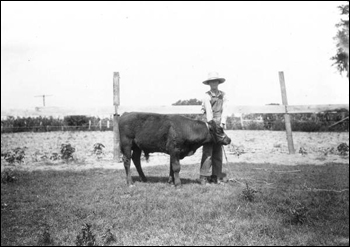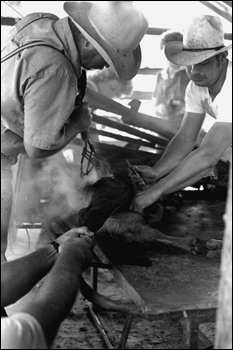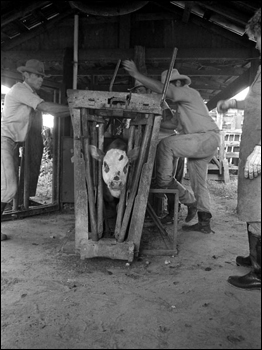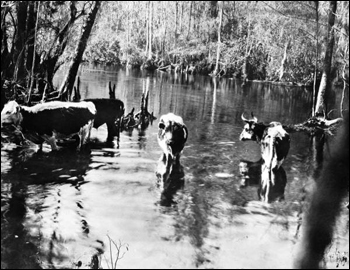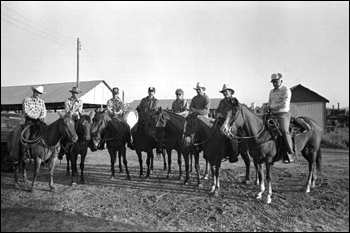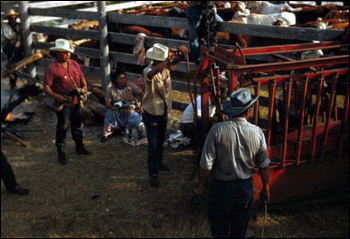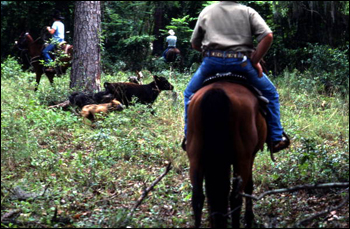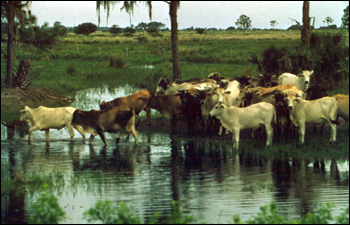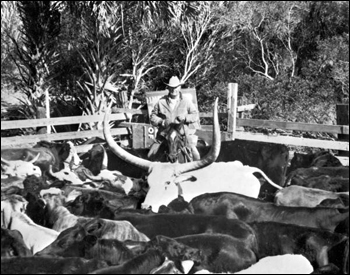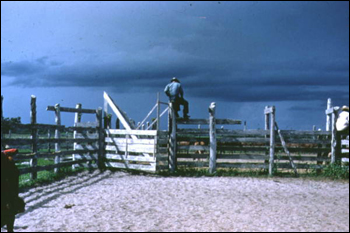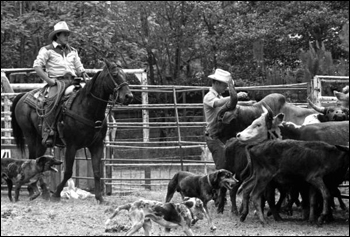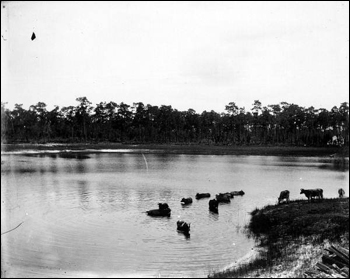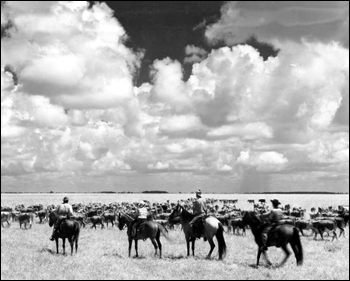Photo Exhibits
Photo exhibits spotlight various topics in Florida history, and are accompanied by brief text intended to place selected materials in historical context.
Florida Cattle Ranching
Ranch Work, Ranch Life
Jackson boy with a shorthorn calf (1919)
Image Number: AG23203
Terry Myers and Ronnie Sylvester castrating, marking, and branding cattle at Buck Island Ranch: Lake Placid, Florida (1984)
Image Number: FA0814
Lloyd McGee, Ronnie Sylvester, and Sarah Childs marking and branding cattle at Buck Island Ranch: Lake Placid, Florida (1984)
Image Number: FA0872
Cowmen and Cowwomen
Ranch work is often a family tradition in which many occupational skills are transmitted through generations. People raised on ranches develop "cow sense," a deep understanding of and ability to predict the behavior of cattle. Members of Florida's ranching community are diverse, encompassing men and women, Crackers, Seminoles, African Americans, and Latin Americans.
Crackers have been a dominant force in Florida ranching since the 19th century. Crackers are sometimes defined as the rural white settlers of Celtic heritage who entered Florida from Alabama, Georgia, and the Carolinas. Historically, Cracker culture reflected many traits derived from rural life in Scotland and Ireland: open-range herding; a leisurely lifestyle with an emphasis on hospitality, food, drink, and outdoor sports; and a strong sense of honor, self-reliance, and tenacity.
Some of Florida's earliest African American cowmen were Black Seminoles—free men or runaway slaves who chose to live with the Seminoles. African Americans who migrated to Florida from other states often brought cattle raising skills with them. Since the 19th century, there have been many African American cowmen throughout the state.
Florida ranching traditions have been influenced by Hispanic culture from Spanish and Minorcan colonists to recent residents. Many Latin Americans who arrived in the late 20th century preserve ranching traditions, though few actively work as ranchers or cowboys. On numerous small ranches in the rural Redland area southwest of Miami, Latin Americans keep horses or recreate the architecture, customs, and leisure activities of their homelands. Many participate regularly in rodeo events within the Latin community.
Range cattle at Wakulla Springs
Image Number: RC15530
Four Seminole girls on a cattle roundup waiting for coffee by a campfire (195-)
Image Number: PE0201
Roger McGee injecting a cow with a worming agent and putting in an anti-fly at Buck Island Ranch: Lake Placid, Florida (1984)
Image Number: FA0821
The crew of the Buck Island Ranch with folklorist Blanton Owen: Lake Placid, Florida (c. 1984)
Image Number: FA0851
Seminole Indian cowboys at the corral: Brighton Reservation, Florida
Image Number: PE0703
Ranch Life
Ranch life is centered around the annual cycle of work generated by the cattle. Most Florida cattle ranchers are in the cow-calf business. On many ranches calves are generally born in the fall and spring. At two to four months they are wormed, vaccinated, earmarked, and the males are castrated. When the calves are 7 to 9 months old they are weaned and sold at weights ranging from 300 to 600 pounds. Since Florida's environment does not support efficient grain production or highly nutritious forages, calves are shipped to western states where they are grazed and fed until they reach finish weights.
Women assume many roles, performing all but the most dangerous and strenuous work. It is not uncommon for them to work cattle from horseback, operate tractors, bale hay, or run errands such as buying feed, veterinary supplies, truck and tractor parts, hardware, and other provisions. Women often maintain the books, manage finances, track political developments that affect the ranch or cattle industry, and are active in youth activities such as 4-H and FFA. Women's auxiliary organizations, such as Florida Cattlewomen, make classroom presentations to inform students about the beef industry. Since the extended matrilineal family is an important social unit, some Seminole women own cattle herds, participate in tribal cattle management, and work at the weighing pens during the annual roundup.
Cattlemen refer to gathering livestock and performing procedures as "working" the cattle. Most cattle require working twice a year. On large ranches cattle are worked year round; smaller herds may require working only every two months. The cattle are herded into pens using a system of gates and chutes to separate the calves, brood cows, bulls and steers. Calves are worked in a mechanical "calf table," a steel frame that holds them in position while multiple procedures are performed. Larger animals are worked in mechanical-hydraulic squeeze chutes. Most Seminole cattle belong to small family-owned herds tended by a central crew under a cooperative arrangement. They often work the cattle by roping and using manpower to handle the stock because cow pens, calf tables, and squeeze chutes may be far away.
Cowboy pushes a baby carriage through the corral: Bonifay, Florida (1949)
Image Number: C012843
Lloyd McGee spraying cattle with a hose at Buck Island Ranch: Lake Placid, Florida (1984)
Image Number: FA0881
Florida cowman reenactor with scrub cattle at Lake Kissimmee State Park: Polk County, Florida (c. 1977)
Image Number: FPS01320
Lake Kissimmee State Park was purchased by the Florida Park Service in 1969 (5,030 acres) and opened for public use in 1977. The park is located 15 miles east of Lake Wales, Florida. The park has often offered living history programs interpreting Florida's cowboy culture and cattle industry. They presented an 1876 cow camp. The cattle were scrub cattle, descendents of the Spanish cattle from the 17th century.
Ronnie Sylvester herding cattle: White Springs, Florida (1984)
Image Number: FS851352
Cattle crossing stream at the Brighton Indian Reservation
Image Number: PE0814
Clark Yates in his cattle pen (19--)
Image Number: RC03265
In the photograph he is framed by the extremely long horns of the longhorn he raised.
Cowboys standing on top of the corral fence (1961)
Image Number: PR01416
Cowboys and catch dogs herding cattle at the Folk Festival ranching area: White Springs, Florida (1984)
Image Number: FA0639
Cattle enjoying a dip in a lake (c. 1910)
Image Number: CC339
Seminole Indian cowboys herding cattle in the pasture: Brighton Reservation, Florida (1950)
Image Number: C013674

 Listen: The Latin Program
Listen: The Latin Program